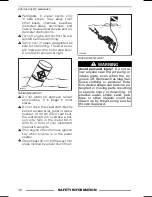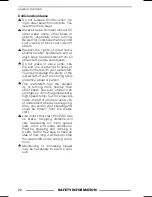
SAFETY EQUIPMENT
Required Safety
Equipment
Always carry the regulatory safety
items and have them conveniently on
board available for use. Check the local
regulations or consult your authorized
Sea-Doo dealer. Such required safety
items usually include, without limita-
tion, a sound signaling device such as
a whistle, a watertight flashlight or ap-
proved flares, a buoyant heaving line,
an anchor and rope*, a bailer*, and
an appropriate fire extinguisher*. The
items marked with a “*” are not re-
quired in Canada if all persons on board
a PWC are wearing a PFD.
The operator and passenger(s) must
wear a Coast Guard approved Personal
Flotation Device (PFD) that is suitable
for PWC use.
The operator and watercraft’s pas-
senger(s) should have ready access
to shatterproof glasses should riding
conditions or personal preference war-
rant. Wind, water spray and speed
may cause a person’s eyes to water
and create blurred vision.
The operator and passenger(s) of
PWCs must wear protective clothing,
including:
– A wet suit bottom or thick, tightly
woven, snug fitting clothing that
provides
equivalent
protection.
Thin bike shorts for example would
not be appropriate. Severe inter-
nal injuries can occur if water is
forced into body cavities as a result
of falling into water or being near jet
thrust nozzle. Normal swimwear
does not adequately protect against
forceful water entry into the lower
body opening(s) of males or fe-
males.
– Footwear,
gloves
and goggles/
glasses are also recommended.
Some type of lightweight, flexible
foot protection is recommended.
This will help reduce possible injury,
should you step on sharp underwa-
ter objects.
F00A
1
2A
Eye
protection
Vest-type
personal
flotation
device
Gloves
Wet suit
or wet suit
bottom
F
oot
protection
Personal Flotation Devices (PFDs)
In many countries, regulations require
that you have at least one approved
personal flotation device (PFD) for
each person on a recreational water-
craft and require that all children under
13 years of age wear a PFD at all times
when the watercraft is underway. You
may not use your watercraft unless
all PFDs are in serviceable condition,
readily accessible, legibly marked with
the approval number, and of an appro-
priate size (within the weight range and
chest size marked on the PFD) for each
person on board.
A PFD provides buoyancy to help keep
your head above the water and to help
you remain in a satisfactory position
while in the water. Body weight and
age should be considered when se-
lecting a PFD. The buoyancy provided
by the PFD should support your weight
in water. The size of the PFD should
be appropriate for the wearer. Body
weight and chest size are common
methods used to size PFDs. It is your
responsibility to ensure that you have
the proper number and types of PFDs
on board to comply with federal and
local regulations and that your passen-
gers know where they are and how to
use them.
________
SAFETY INFORMATION
________
15
Summary of Contents for 2009 Sea-Doo GTI Series
Page 9: ...SAFETY INFORMATION ________ SAFETY INFORMATION ________ 7...
Page 39: ...VEHICLE INFORMATION _______________ 37...
Page 83: ...MAINTENANCE INFORMATION _______________ 81...
Page 100: ...STORAGE AND PRESEASON PREPARATION 98 ______________...
Page 101: ...TECHNICAL INFORMATION _______________ 99...
Page 114: ...SPECIFICATIONS 112 ______________...
Page 115: ...TROUBLESHOOTING ______________ 113...
Page 123: ...WARRANTY ______________ 121...
Page 142: ...140 ______________...
Page 144: ...142 ______________...
Page 146: ...144 ______________...
















































